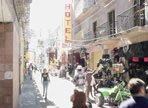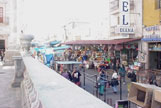Click on the thumbnail image to view a larger image.
The tradition of offering votive objects (that is, objects pertaining to a vow) to Christ, the Virgin, and the saints in expectation of, or in thanks for, divine aid, dates from the early years of Christianity. At least since the 16th century, these offerings have included small paintings, called ex-votos. This tradition was brought by the Spanish to the New World and flourished in Mexico and elsewhere. One of the places in Mexico where this tradition still thrives is San Juan de los Lagos, to which pilgrims flock to pray to the Virgin who dwells there.
The town of San Juan de los Lagos is located in the eastern part of the state of Jalisco in west central Mexico, approximately 120 kilometers northeast of Guadalajara. The shrine to Nuestra Señora de San Juan de los Lagos (Our Lady of St. John of the Lakes) is one of the principal pilgrimage sites in Mexico, perhaps second only to that of Guadalupe near Mexico City.
 |
< Street across the plaza from the basilica. | Looking from the portico at the right side entrance to the basilica, onto the adjacent street. > |  |
The story of the Virgin of San Juan begins in 1542, when the Spanish priest, Father Miguel de Bologna, brought an image of the Virgin of the Immaculate Conception to the village. Some years later—in 1623—the legend recounts that the daughter of Indian parents fell gravely ill, and her death was imminent. However, after the parents earnestly prayed to the Virgin, their daughter was saved.
As a result of this miracle, there was a steady increase in the number of pilgrims who came to the Virgin, not only Indians, but Spanish and mestizo as well. The Virgin acquired her own local identity as Our Lady of San Juan de los Lagos, separate from her original identity as the Immaculate Conception. From the early 17th century, a fair was held each year around the anniversary of the statue's installation in the shrine (November 30). This market fair increased in popularity until the middle of the 19th century, after which time attendance declined. The fair was terminated in the early 1900s, although a fiesta is still held.
Construction began on the present church in 1732. The church was built in the Mexican baroque style of the time, with an ornamented facade surrounded by the plainer lower walls of the bell towers. Although the towers were not completed until 1790, the Virgin was installed in the new church in 1769. Pope Pius XII recognized the church as a basilica in 1972. The church was elevated to the Cathedral of the Diocese of San Juan de los Lagos by Pope Paul VI.
| < Facade of the basilica, from the plaza. | Top level of the facade, with a sculpture of Nuestra Señora de San Juan de los Lagos. > |
Inside the church, the Virgin stands on a platform placed above the main altar. The platform includes an upturned crescent moon, reminiscent of the origins of the image as the Immaculate Conception. Golden candelabra adorn the altar. (In post-Vatican II style, there is an additional smaller altar placed further forward in the sanctuary.) The platform is inside a cupola supported by Ionic columns, approximately six feet in height. Above the cupola is a golden half-dome, itself supported by even larger columns. In the half-dome, two sculpted angels hold a banner over the Virgin's head with the Latin phrase, "Mater Immaculata, ora pro nobis" (Immaculate mother, pray for us). Several additional sculptures are set in the back wall of the sanctuary. To the left of the main altar is a chapel to Our Lady of Guadalupe. To the right is the ex-voto room, to be discussed below.
The statue of the Virgin of San Juan is about 20 inches tall and was constructed according to the titzingueni technique used by the Tarascan Indians of Michoacán. Thus, the statue probably derived from that area. (The current state of Michoacán is immediately to the south of Jalisco.) Vasco de Quiroga, noted churchman and bishop of Michoacán in 1537, encouraged the Indians to adapt their pre-Hispanic sculpting technique to the making of Christian images. In the indigenous technique, the sculptor prepared a paste from a mixture of corn pith and orchid juice. The paste was then molded over a frame of cane or wood, after which the figure was coated with gesso and painted. Besides the Virgin of San Juan de los Lagos, there are a few other cult statues still extant in Mexico, such as Nuestra Señora de Salud (Our Lady of Health) in Pátzcuaro and the Virgin of Zapopan in Guadalajara, that were made by means of this technique.In the late 16th or early 17th century, the Virgin's statue was "modernized," in one of the styles of the day, by enclosing her in a frame over which was draped lavish clothing. Now only the Virgin's hands, folded in prayer, and her head with long brown hair, are exposed. Over her head is placed a golden crown. At her feet is an upturned crescent moon. She wears a white gown over which is placed a blue robe, indicating her colors of blue and white. Sometimes, however, she is dressed only in white. The folded hands and crescent moon are related to her original role as the Virgin of the Immaculate Conception.
| < The Virgin of San Juan de los Lagos behind glass in the columned cupola. | Closer view of the Virgin, with the sculpted angels. > |
In 1836, the Pope ordered that a special room be constructed to house the votive offerings that were brought to the Virgin. This room was consecrated by the Archbishop of Guadalajara in 1884. It is located to the right of the main altar and is covered from floor to ceiling with votive paintings and other offerings.
Besides the ex-voto paintings, the votive offerings include girls' dresses and other children's clothing, religious prints, written texts, children's drawings, photographs, miniature or toy vehicles, locks of hair, and statues of the Virgin. The last photograph above shows a model ship with the words "Por un favor recibido R.R.G." ("For a grace received," and the donor's initials). This ship recollects ex-votos from centuries past in Mexico and Mediterranean countries in which mariners offered thanks to the Virgin for salvation from storms or other maritime disasters.
The sign in the previous picture quotes a scriptural passage: "No todo el que me diga: Señor, Señor, entrará en el Reino de los Cielos, sino el que haga la voluntad de mi Padre Celestial." MT 7,21 ("Not everyone who says to me, Lord, Lord, will enter into the Kingdom of Heaven, but he who does the will of my Heavenly Father." Matthew 7:21).
The ex-voto paintings typically include two parts: first, a text that states the donor's prayer to the Virgin, describes the miracle received, and offers thanks (or all three); and second, a picture of the miracle or of the donor praying before the Virgin.
|
< Ex-voto to the Virgin of San Juan de los Lagos. 1944. |
Ex-voto to the Virgin of San Juan de los Lagos. ca.1950-75. |
These two ex-votos are typical of those offered to the Virgin of San Juan. The one on the left is from San Francisco del Rincon, in the neighboring state of Guanajuato. The text describes the case of a man who was gravely ill from a rheumatism-like disease in 1944. After his wife fervently prayed to the Virgin of San Juan de los Lagos for his recovery, the Virgin healed him. The painting shows the husband lying ill while the wife prays. The Virgin is shown crowned, with folded hands, standing on her pedestal, and wearing her blue robe over white gown. The red arc beneath her gown and the arc of clouds allude to the crescent moon beneath her feet.
In the ex-voto on the right, which is from San Juan de los Lagos, a man kneels holding a baby. Although the text has worn away, we may surmise that he is praying to the Virgin for the health of his child. Here too the Virgin is crowned, holds her hands folded in prayer, stands on a pedestal, and wears her blue and white garments. In this picture, the upturned crescent moon is clearly indicated. Two angels unfurl a banderole that proclaims the Virgin as the Immaculate Conception.
There are several other shrines in Mexico at which large numbers of ex-voto paintings are offered. These include the shrine of Our lady of Guadalupe near Mexico City, the church of San Francisco de Asís in Real de Catorce, San Luis Potosí, and the sanctuary of Santo Niño de Atocha in Fresnillo, Zacatecas. Many other churches in Mexico, and in areas of the United States where Mexican-Americans live, receive a smaller number of pilgrims who offer votive paintings and other objects.
|
Zapopan |
Zapopan |
Chimayo |
The picture on the left shows the small shrine of the Lord of Sacromonte, located just outside the nave of the church of Our Lady of Zapopan in Guadalajara. Several paintings and other votive items offered to the Lord of Sacromonte can be seen placed on the ledge on either side of the statue of the buried Christ. In the center is a collection of votive paintings offered to the Virgin of Zapopan, who, like the Virgin of San Juan de los Lagos, is a miraculous local Virgin from early colonial times. The photo on the right shows votive paintings (to Guadalupe and San Antonio) offered at the Sanctuary of Our Lord of Esquipulas in Chimayo, New Mexico.
In San Juan de los Lagos, so many ex-votos and other votive objects are offered to the Virgin, that the room at the side of the church is insufficient to contain them. Another building was constructed a couple of blocks from the church in which many more votive offerings are housed. The vast quantity of these offerings indicates the great esteem in which Nuestra Señora de San Juan de los Lagos is held by the faithful.
For More Information
Durand, Jorge, and Douglas S. Massey. 1995. Miracles on the Border: Retablos of Mexican Migrants to the United States. pp.59-62. Tucson: University of Arizona Press.
(Contains many excellent examples of ex-votos to the Virgin of San Juan; see figures 1-3, 5-11, 13, 15-19, 21-23, 26, 27, 29-32, 35)Giffords, Gloria Fraser. 1992. Mexican Folk Retablos. Revised Edition. pp.60-61. Albuquerque: University of New Mexico Press.
Oblate Fathers. 1991. "A Short History of the Virgin of San Juan del Valle Shrine." Pamphlet. San Juan, TX: Oblate Fathers.
(Information about a "sister" shrine in Texas)See also the additional articles on the Kalarte Gallery Web site: Ex-Voto Retablos and Mexican Devotional Retablos.
Copyright © 2004-20011 Kalarte Gallery and Bernard Cesarone
![]()